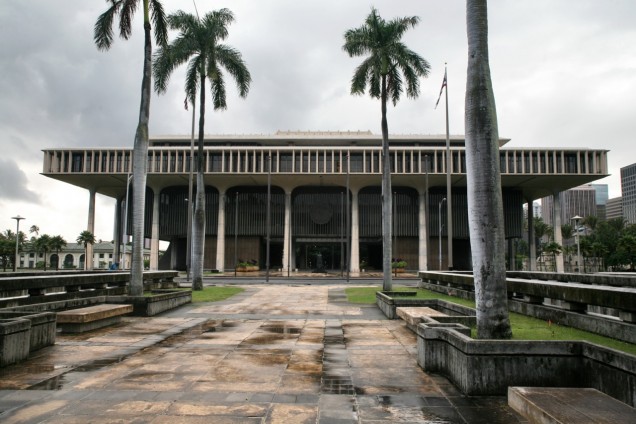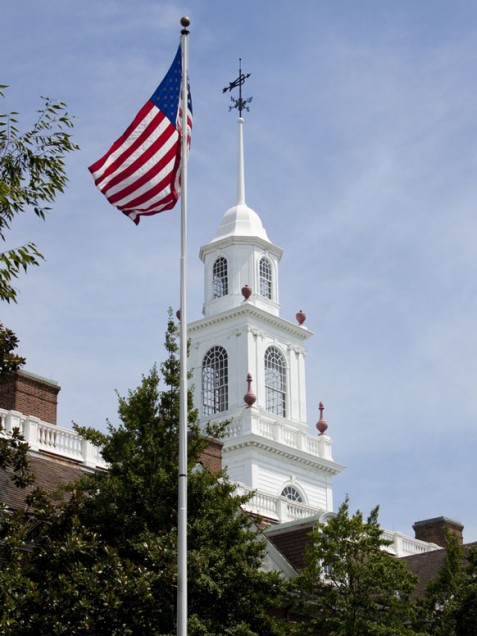Category: State Legislation
At Last: New York Remembers the Adolescence of its Juveniles Offenders
On April 10th of this year, New York became the 49th state to pass legislation ending the treatment of 16 and 17 year olds as adults in the criminal justice system. Assembly Speaker Carl Heastie touted the bill’s passage as a “tremendous victory for communities across the state that have endured senseless tragedies and called on the Legislature to deliver a justice system that recognizes the difference between a child and an adult.” While New York was one of only two states to continue to prosecute these juveniles as adults, the Assembly had been working to pass similar legislation for over 12 years.
The prosecution of juveniles in adult criminal court has been proven to have serious lifelong consequences. The human brain is not fully developed until the age of 25, before juveniles mature they often lack impulse control and the ability to anticipate and understand the consequences of their actions. Adolescents tend to be receptive to interventions, responding well to juvenile treatment and services by learning to make responsible choices and ending delinquent behavior. Studies show that youth offenders prosecuted and sentenced in the adult criminal justice system are 34% more likely to be re-arrested than juveniles who are charged in the youth justice system. In addition to the impact that the adult criminal justice system has on the juvenile’s future behavior, youth offenders detained in adult prisons are more likely to be beaten by staff, sexually assaulted, 50% more likely to be attacked with a weapon, and are 36 times more likely to commit suicide while detained.
New York’s Raise the Age bill has multiple facets. Under the new legislation, 16 and 17 year olds accused of misdemeanors will be sent to Family Court. Felony cases, however, will remain in adult criminal court in a new section called the “youth part,” which will house judges trained in Family Court law. After 30 days, 16 and 17 year olds charged with nonviolent felonies will be sent to Family Court unless a district attorney has proven that there are “extraordinary circumstances” that warrant the juvenile’s retention in the adult criminal system. The term “extraordinary circumstances” is undefined in the new law, although Alphonso David, the governor’s counsel, has stated his belief that it will be widely understood to mean “remarkable, exceptional, amazing, astounding, incredible.” Those juveniles charged with violent felonies may also be transferred to Family Court if they pass a three-part test. The test balances whether the victim sustained significant physical injury, the accused used a weapon, and whether the perpetrator engaged in criminal sexual conduct.
The bill also changes the rules regarding the detention of juveniles. After the horrible details surrounding the arrest and detention of Kalief Browder became public knowledge, there was a powerful push for juvenile detention reform. Kalief Browder was a 16-year-old kid living in the Bronx in 2010 when he was arrested for allegedly stealing a backpack. Mr. Browder never faltered in his denial of guilt, despite this he was detained on Rikers Island for 3 years, two of which were spent in solitary confinement, without charges. The time spent on Rikers, replete with assaults by guards and inmates, solitary confinement, and awaiting a trial that never came affected his mental state in ways that would be expected of anyone, let alone a teenager. Two years after his release from Rikers Island, Mr. Browder committed suicide and became a household name reflecting the horrors of the criminal justice system for the youth of New York. The Raise the Age legislation, signed by Governor Cuomo with Kalief Browder’s brother, Akeem, looking on, is an attempt to prevent a tragedy such as this from ever occurring again. Beginning October 1st, 2018, offenders under 18 will no longer be held at Rikers Island and those 17 years old will no longer be held in county jails, a similar rule will be enforced for those under 18 a year later.
Despite victory for proponents of the bill, many are disappointed in the newly passed legislation. Last year alone, 3,445 juveniles were charged with violent felonies and therefore would still have been prosecuted in the “youth part” of the adult criminal system. Those adolescents will continue to receive lengthy prison stays and lifetime criminal records. Kevin Parker, a State Senator from Brooklyn, voiced his consternation at how complicated this bill became, “[a]ll we had to simply do is say that we’re going to take 16- and 17-year-olds and we’re going to treat them just like 15-year-olds. That’s all we had to do, right? All we had to do. And we messed that up.”
While New York’s bill may not be perfect, it will give many young offenders an opportunity to learn from their mistakes and become law-abiding adults. Over 17,000 adolescents aged 16 and 17 are accused of misdemeanors each year, under the new bill these charges will be heard in family court where judges are trained to know what is best for the adolescent offender and have more access to social services that may help rehabilitate rather than strictly penalize this vulnerable community. The change in detention facility alone will mean the difference between a mistake and lifetime behavior for many, for some it will mean the difference between life and death. A staunch supporter of the original bill, Senator Diane Savino of Staten Island, made it clear that the fight to raise the age for adult criminal liability is far from over. “For those who don’t think it goes far enough, I will remind you: We are not dropping off the end of the earth tonight. Laws are made to amend them.”
 Alexandra Raymond is from Vergennes, Vermont and graduated from New York University in 2014 with a B.A. in Sociology and Law & Society. She is expected to earn her Juris Doctor from Boston University School of Law in 2018. Alexandra will be working for an investment management firm in Boston during the summer of 2017 and will then spend her next semester studying international law at Leiden Law School in the Netherlands. Upon graduation, Alexandra hopes to pursue a career that allows her to explore her interests in business, social justice, and international law.
Alexandra Raymond is from Vergennes, Vermont and graduated from New York University in 2014 with a B.A. in Sociology and Law & Society. She is expected to earn her Juris Doctor from Boston University School of Law in 2018. Alexandra will be working for an investment management firm in Boston during the summer of 2017 and will then spend her next semester studying international law at Leiden Law School in the Netherlands. Upon graduation, Alexandra hopes to pursue a career that allows her to explore her interests in business, social justice, and international law.
Negotiating with Goliath: Lawmakers’ battle with Uber & Lyft over ridesharing legislation
As I stepped off the plane and into the jet bridge, I already had my Uber app opened on my smartphone, and only a few short minutes after requesting a ride, the driver was calling me to tell say that he was outside baggage claim. This kind of convenience and ease that e-hailing companies like Uber and Lyft provide is what we have grown accustomed to as consumers.
E-hailing companies, or transportation network companies (TNCs), have made finding a ride very convenient for city dwellers and travelers alike. Whether it is one of the main players like Uber or Lyft, or one of the newer startups like Juno, Fasten, or Gett, TNCs have become an integral part of how we travel and for some of us, our everyday lives.
As convenient as TNCs are, legislatures across the country have made it clear that these companies will not be free from regulation. Rather, city and state legislatures have proposed legislation that will both allow TNC, but also protect riders.
In early February 2017, New Jersey Governor Chris Christie signed a new law making the Garden State the most recent of the 36 states to regulate TNCs. This new law, the Transportation Network Company Safety and Regulatory Act, which is similar to Massachusetts’s 2016 law, requires that TNC companies cover up to $1.5 million dollars in liability insurance and that drivers get background checks. However, TNC drivers are still not subject to the same fingerprinting background checks as taxi drivers. Additionally under the law, the public still does not have access to the safety records of drivers, a concession made by lawmakers in its negotiations with Uber. Municipalities are also prohibited from taxing TNC companies, promoting a more uniform single statewide regulation.
The New Jersey legislation did not come without a fight, however, with Uber demanding limits to regulations. In fact, Uber, throughout its many negotiations with city and state legislatures around the country, has consistently threatened to withdraw all of its business in the city or state at issue if the legislature does not adopt its preferred regulations. This is especially true when it comes to the fingerprinting requirement, which Uber particularly opposes. According to Uber, requiring drivers to get fingerprinted would make it harder to recruit drivers. Uber also claims that the requirement would be unfair to minority applicants, as fingerprint background checks only indicate arrests, not convictions, and false arrests are more frequent in minority neighborhoods.
Prior to the enactment of New Jersey’s statewide law, Uber had been in contentious negotiations with many New Jersey cities including Newark, the State’s largest city by population. In the end, Newark and Uber were able to come to an agreement, and Newark passed a now pre-empted ordinance where Uber would pay Newark $10 million in fees, and drivers would be required to get background checks by a nationally accredited third-party, but there would be no fingerprinting requirement.
Austin, Texas, however, had a different experience. Austin’s city council passed an ordinance requiring driver background checks with fingerprinting. Rivals Uber and Lyft joined forces and campaigned for Proposition 1, which would repeal the ordinance. The two companies spent $8 million dollars on advertising, or $200 per vote to get their message across. Yet, the campaign failed to sway voters, and Proposition 1 lost 44% to 56%. The day after the election, Uber and Lyft made good on their threat to withdraw their services from the area, leaving drivers and riders unable to use either app in the Austin area. Uber did the same to other Texas cities Midland, Corpus Christi, and Galveston, leaving because it did not agree with the local ordinances that had been passed.
Ending service so abruptly had a negative impact on riders who had become accustomed to this mode of transportation and drivers who relied on both companies for a source of income. Austin eventually set up a hotline and job fair for these suddenly out-of-work Uber and Lyft drivers. Luckily for Austin, riders and drivers were not left out in the lurch for too long, as entrepreneurs and new e-hailing companies quickly filled the void left by the two giants. Uber and Lyft left on May 9th and by the summer, there were ten companies who were set up and ready to compete. More than that, these new companies were able to get roughly 9,000 drivers to sign up and all of the companies met the August 1 deadline to have at least half of their drivers fingerprinted. All of the companies had to be in full compliance with the ordinance by February 1, 2017.
Ironically, these hard-fought battles between Uber and Lyft and America’s largest cities might all be for naught. Despite Austin’s city council’s win in keeping their city ordinance on the books, the state legislature passed, and on May 29th Governor Greg Abbott signed, a statute that pre-empted Austin’s ordinance. Since a local government only has the authority granted to it by the state, when state and local laws conflict, the local law will typically be pre-empted. Abbott stated, "In Texas we don't believe in heavy-handed, top-down, one-sided regulatory environm
ents that erect barriers for businesses, in Austin, Texas, we're going to override burdensome, wrongheaded regulatory barriers that disrupt the free-enterprise system upon which Texas has been based and upon which has elevated Texas to be the No. 1 state in the entire country for doing business." Texas joined other states, which have increasingly preempted local ordinances. The most recent and notable example is North Carolina’s HB2 law, which pre-empted Charlotte’s anti-discrimination ordinance.
Pre-emption in regards to TNC legislation may not be so terrible, however. There is a great benefit to both the state and companies to have one standard rather than multiple municipal ordinances. With a service such as ridesharing, it is not uncommon for someone to be picked up in one town and dropped off in another. Because of this reality, it may be preferable for the states to take the lead.
New Jersey's law shows the trend is certainly moving in the direction of state legislation, not municipal. However, now the question is will state legislatures remain strong in their positions or will they give in to what Uber and Lyft demand? As we have seen in Austin, there will always be a new company who is willing to comply with the new regulations if Uber and Lyft will not. Therefore, perhaps states should pass the ideal legislation that they feel best protects its citizens and let the market sort itself out. Uber and Lyft have a lot of negotiating power because they are the biggest players, but as we have seen, they do not have an impenetrable monopoly. As the city of Austin found out, the TNC market will not crash if Uber and Lyft leave. There are plenty of worthy “Davids” who would jump at the chance to fill the void of Goliaths Uber and Lyft, even if in the face of stricter regulation.
 Merissa Pico is from Fort Lee, New Jersey and graduated summa cum laude from Boston University’s College of Communication in 2015 with a B.S. in Mass Communication Studies. She is expected to earn her J.D. from Boston University School of Law in 2018. Merissa will be working at Ropes & Gray in New York City in the summer of 2017 and is looking forward to continuing to explore her interests in entertainment and communications law.
Merissa Pico is from Fort Lee, New Jersey and graduated summa cum laude from Boston University’s College of Communication in 2015 with a B.S. in Mass Communication Studies. She is expected to earn her J.D. from Boston University School of Law in 2018. Merissa will be working at Ropes & Gray in New York City in the summer of 2017 and is looking forward to continuing to explore her interests in entertainment and communications law.
The Role of the Courtroom in Combating Domestic Violence
The rhetoric surrounding the courtroom can be idealistic. The courtroom is supposed to be a symbol of justice, where every party has a fair opportunity to be heard. Yet the reality for survivors of domestic violence is far from this ideal. Survivors who have the strength to seek their day in court have already shown an incredible amount of strength and courage. They should be met with hope, encouragement, and assistance. But this is a goal yet to be achieved.
Survivors often feel unsafe walking into the courtroom. Not only are survivors at more risk after leaving their abuser, “[a]busers also use court appearances as opportunities to stalk and maintain contact with their ex-partners.” Survivors face an uphill battle in the courtroom. As Sara Ainsworth of Legal Voice stated, “[t]here's an enormous bias against anyone making accusations [of abuse].”
Domestic violence survivors may end up in the courtroom for a variety of reasons, including seeking a protective order and child custody proceedings. Current law in Massachusetts governing domestic violence in custody proceedings falls far short of the protection society owes to survivors. First, the definition of abuse is narrow, only encompassing physical abuse. Specifically, Massachusetts General Laws Section 31A defines abuse as “(a) attempting to cause or causing bodily injury; or (b) placing another in reasonable fear of imminent bodily injury.” The statute further states that either a pattern of abuse or a ‘serious incident’ of abuse (defined as “(a) attempting to cause or causing serious bodily injury; (b) placing another in reasonable fear of imminent serious bodily injury; or (c) causing another to engage involuntarily in sexual relations by force, threat or duress”), triggers a rebuttable presumption that granting the abuser sole or shared custody is not in the best interest of the child. The presumption is triggered by a preponderance of the evidence, and can be rebutted by a preponderance of the evidence. A past or current protective order does not automatically trigger the presumption.
Further, while the facts that brought about a protective order can be admissible, protective orders themselves cannot be admitted as evidence of abuse. This means that even if a survivor has succeeded in protecting herself and her child(ren) by obtaining a protective order, she will not automatically get custody of her children. She will have to face her abuser again in the courtroom, and will have to prove once again that abuse has occurred. Further, even if there was extensive verbal, emotional, and psychological abuse, the presumption against custody will not be triggered.
In addition to dealing with statutes that do not adequately protect them, survivors must also deal with judges who may not understand their experiences. In fact, women who are seeking protection for themselves and their children from an abuser are often met by similar behavior from judges. Domestic abuse is often described with what is termed the ‘Power and Control Wheel.’ The wheel describes that variety of ways abusers use their power to manipulate and control their victims. The Texas Council on Family Violence created a power and control wheel that describes the ways judges also reinforce women’s entrapment.
The role of the court in protecting domestic survivors must extend beyond equitable orders. It is an unfortunate truth that sexism is still a very real reality in the courtroom. Moreover, many judges do not understand the dynamics of domestic violence, and do not handle custody disputes with the appropriate sensitivity to domestic abuse, even if they are statutorily required to do so. Judges have the opportunity to empower victims, or to make them feel even less in control.
The idea that judges can play a positive role in protecting domestic abuse survivors is not new. In 1999, The Northeastern University Press published an article titled “Battered Women in the Courtroom: The Power of Judicial Responses.” The article lists multiple ways judges can support survivors: supportive judicial demeanor; take the violence seriously; make the court hospitable; prioritize women’s safety; address the economic aspects of battering; focus on the needs of children; enforce orders and impose sanctions on violent men; and connect women with resources. Specific recommendations targeted sexism during proceedings, including “refusing to joke and bond with violent men”; “talking with battered women rather than around them”; “correcting institutional bias in favor of men”; and “eschewing bureaucratic/perfunctory or hostile attitudes toward victims and casual or collusive attitudes with batterers.”
The article identified five types of judicial demeanor in hearings for protective orders: 1) good-natured; 2) bureaucratic; 3) firm or formal; 4) condescending; and 5) harsh. Interestingly, “[t]here types . . . were demonstrated toward violent men[:] [f]irm or formal, bureaucratic and good-natured. Most judges were good-natured with women and firm with violent men. Condescending and harsh demeanor was not directed toward violent men.” (emphasis added). There is no excuse for the gender discrimination revealed by this study.
While this study is dated, women still face judges who are hostile toward domestic violence survivors. Judges can make a difference by understanding that survivors can be overwhelmed in the courtroom; ensuring a the record is comprehensive; not blaming the victim; and having zero tolerance for violence and gender discrimination during proceedings.
Judges can be powerful role models by choosing to treat women with respect and taking the humble approach of recognizing their need to learn the dynamics of domestic abuse in order to be effective judges.
Boston University School of Law, class of 2018
Raising the Minimum Wage: Look No Further Than Your Own Backyard
By: Brynn E. Felix
The United States has a minimum wage problem. In 2015, roughly 2.6 million workers earned at or below the federal minimum wage—a measly $7.25 per hour. The federal minimum has not budged since 2009 and continues to depreciate in value: by 2015 the $7.25 hourly wage had already lost approximately 8.1% of its purchasing power to inflation. With a looming Trump administration likely falling in lock-step with a Republican-controlled House and Senate, it seems safe to predict that the federal minimum isn’t going anywhere for the next four years.
Efforts by Democrats to raise the federal minimum wage to $10.10 largely stalled out, even after a letter signed by 600 economists supported the hike. Citing “close to 17 million workers” who would benefit from the raise, the economists pointed to
“important developments in the academic literature on the effect of increases in the minimum wage on employment, with the weight of evidence now showing that increases in the minimum wage have had little or no negative effect on the employment of minimum-wage workers, even during times of weakness in the labor market. Research suggests that a minimum-wage increase could have a small stimulative effect on the economy as low-wage workers spend their additional earnings, raising demand and job growth, and providing some help on the jobs front.”
Pros & Cons of Increasing the Minimum Wage
In addition to the economic arguments provided by the 600 economists who favor raising the minimum wage, proponents also point to the fact that the current minimum wage fails to provide a living wage for workers living in urban centers and places with higher costs of living. Indeed, the value of the minimum wage has significantly declined since the 1960s and 1970s. Moreover, low wage earners are more likely to spend the majority of their income locally, which benefits the local economy. In addition to the economic arguments, proponents have effectively framed the narrative as pursuit of economic justice. Too many working families are struggling to make ends meet, juggling multiple jobs with no relief in sight.
 Critics claim that forcing businesses to raise the minimum wage will inevitably cause them to reduce their employment ranks, rendering “many less skilled workers unemployable.” A wage hike would mean fewer jobs and an increase in unemployment. In response to Senator Bernie Sanders’ proposal to raise the federal minimum wage to $15, the Heritage Foundation claimed that approximately seven million full time jobs would be eliminated by 2021. Moreover, doubling the federal minimum wage would have a greater impact on states with lower costs of living. In a nutshell, opponents decry minimum wage increases as “’feel good, sound good’ policies that appease the masses, harm businesses, and displace workers.”
Critics claim that forcing businesses to raise the minimum wage will inevitably cause them to reduce their employment ranks, rendering “many less skilled workers unemployable.” A wage hike would mean fewer jobs and an increase in unemployment. In response to Senator Bernie Sanders’ proposal to raise the federal minimum wage to $15, the Heritage Foundation claimed that approximately seven million full time jobs would be eliminated by 2021. Moreover, doubling the federal minimum wage would have a greater impact on states with lower costs of living. In a nutshell, opponents decry minimum wage increases as “’feel good, sound good’ policies that appease the masses, harm businesses, and displace workers.”
Fight for 15
The Republican-controlled 114th Congress needed no further convincing.
Seeing their prospects fade at the federal level, minimum wage advocates have reacted by strategically shifting their efforts to local reforms. Municipalities in particular have become the forefront of the movement for a living wage.
Seattle was the first major metropolitan city to enact a minimum wage hike amid the failed effort to increase the federal minimum wage. In early 2014, Seattle saw months of contentious debates and public demonstrations, bringing thousands of strikers and economic justice activists to the streets. The “Fight for 15” campaign had officially begun.
“It was the experience of a lifetime,” said former McDonald’s worker Martina Phelps. “After seeing my co-workers literally struggling and not having enough money to take care of their children, it was set in my mind that I can do something about this.”
Labor triumphed. By June of 2014, the Seattle City Council unanimously approved a city ordinance that raised the $9.50 an hour wage to $15 an hour. “No city or state has gone this far,” one councilmember noted, “We go into uncharted territory.” The ordinance contains different phase-in schedules that vary by business size: employers with 500 or more employees will pay $15/hour by 2017, while smaller businesses have until 2021 to gradually implement the raise. The first increases took place in April of 2015, while large employers currently pay $13/hour.
Building on Seattle’s success, the Fight for 15 spread like wildfire to other urban centers and state legislatures.
By December 2015 Chicago mayor Rahm Emanuel signed into law an ordinance to raise the city’s minimum wage to $13/hour by 2019. Three months later California legislators enacted a law that will elevate the state minimum wage to $15/hr by 2022. New York legislators followed suit with their own $15/hr measure, which will take effect in New York City by 2018.
In the meantime, the University of Washington’s Evans School of Public Policy and Governance published a study in July 2016, noting that Seattle’s wage increase had elevated the pay of minimum wage workers by nearly 12%, in contrast to a 5% increase seen by workers just outside the city limits. While the preliminary study concluded that low-wage workers’ employment levels and wages rose, the media continued to promote polemic interpretations of the study’s results. Supporters and opponents alike, eager to vindicate their own predictions, used the report to claim victory over their opponents. These two headlines are from the Seattle Times (July 25, 2016) and Forbes (July 26, 2016), respectively:
What actually happened? In reality, by July 2015, data demonstrated that the wage hike had a minor impact on employment and numbers of hours worked, along with significant increases in wages earned. Signs of misleading reporting were documented by the New Yorker: “Last February [2016], the Washington Policy Center and the American Enterprise Institute suggested that several Seattle restaurants were closing in anticipation of having to pay their staff more, though when a Seattle Times report went out to interview the owners she found more mundane causes: a bad location, a rebranding.“
Despite several media outlets prophesizing negative economic consequences of raising the minimum wage, voters in Arizona, Colorado, Maine, and Washington overwhelmingly approved November ballot measures to increase their respective state minimums. In total, 29 states now offer a higher minimum wage than the federal minimum.
Where do we go from here? Oregon may give us a clue.
With a few exceptions, the “Fight for 15” victories largely occurred on Democratic turf. In its article, The Bitter Lesson From Seattle’s Minimum Wage Hike, Investor’s Business Daily lamented:
“[S]uch foolishness seems to have infected the Democratic Party, with its now near-ubiquitous ‘Fight for $15’ campaign…forcing sharply higher wages on troubled local economies where the median wage is low and can have a devastating effect.”
Fears that increasing the minimum wage could harm states with lower costs of living are not unfounded; however, that alone should not be the reason for jurisdictions to reject minimum wage increases. Indeed, Oregon offers an innovative model that addresses concerns about significant economic disparities head on. In March of 2016 the Oregon State Legislature enacted a statewide law that raises the minimum wage, set at $9.25 at the time of passage, to $12.50, $13.50, or $14.75 by 2023—depending on the region. To accommodate both the high cost of living in Portland and the economic differential in nonurban counties, the legislature devised a system that divides the state into three regions: Standard, Portland Metro, and Nonurban Counties. By 2023, the Standard minimum wage will reach $13.50 and will be adjusted annually to compensate for any increases to the Consumer Price Index for All Urban Consumers. The Portland Metro area will hover at $1.25 above the Standard wage, while the minimum wage in Nonurban Counties will be fixed at $1 below the Standard minimum:
This multi-layered approach addresses many of the issues that may arise when different regional economies are subjected to uniform across-the-board wage hikes. By centrally managing wages by locality, Oregon was able to legislate for each sub-region’s unique economic situation. While such a plan might prove to be unconstitutional at the federal level due to the requirement that states be treated equally under the law, this approach may nevertheless provide a blueprint for other states that struggle with satisfying the needs of wildly different demographics.
The Takeaway
One of the greatest silver linings to emerge from the gridlock, obstructionism, and ever-intensifying polarization of Congress is the reminder that inaction at the federal level does not have to stall progress at the local level. Municipalities and local governments have proven to be successful incubators of policies that help the working poor. In Washington, a bold proposal in 2014 to raise the city’s minimum wage to $15 an hour catalyzed momentum for a statewide vote in 2016 to raise the state’s minimum wage to $13 an hour. Similarly, state legislatures like Oregon are adopting wage increases with creative and innovative implementation schemes. Only time will tell what effects these experiments will have—and how the media will attempts to shape the underlying narrative—but in the meantime, local advocates and policymakers should take full advantage of these beautiful laboratories.
Up In Smoke (and Vapor): Hawai’i Raises Minimum Smoking Age and Regulates E-Cigarettes
On January 1, 2016, Hawai’i became the first state in the nation to increase smoking age restrictions to 21 years old. Under Act 122, Hawai’i prohibits the “sale, purchase, possession or consumption of cigarettes, other tobacco products, and electronic smoking devices (or e-cigarettes) to anyone under age 21.” Before Hawai’i, only municipalities such as New York City and Needham, Massachusetts restricted tobacco sales to individuals under 21 years old. States however, remain more conservative, with Alabama, Alaska, New Jersey, and Utah increasing the minimum age to buy tobacco to 19 years old. The Hawai’i law began a wave of amendments to state tobacco laws. As of July 14th, 13 states (including Hawai’i) raised their minimum legal sale age to 21 years old, as have 170 different municipalities across the nation. Although raising the minimum age to purchase tobacco is a momentous step, there is another important feature of the Hawai’ian law that some other states also adopted in their bill language. The bill restricts sales and uses of electronic smoking devices, commonly referred to as “e-cigarettes.”
In the tobacco restriction movement, proponents for increased age minimum laws argue that a majority of smokers become addicted to cigarettes before their 21st birthdays. According to New York City Health Commissioner Thomas Farley, restricting laws deter young people from smoking all together because the laws make it difficult for the adolescent to access nicotine. Farley asserts, “an 18-year old can buy [cigarettes] for a 16-year-old.” A high school sophomore can go down the hall of his high school and ask an 18-year-old peer to buy him, or bum him, cigarettes. With the age minimum at 21 years old, that high school sophomore would “have to find someone in college or out in the workforce” in order to obtain cigarettes. This obstacle of significantly decreased accessibility to of-age-buyers makes cigarettes less obtainable for high school students.
The August 26, 2013 issue of Annals of Internal Medicine included a hypothetical health policy model that increased the minimum age for tobacco sales to 21 years old. The model projected that youth smoking rates could drop from 22% to less than 9% amongst 15 through 17-year-olds in seven years with the right legislative initiative. The Hawai'i Department of Health and University of Hawai'i both offered testimony to the Legislature in support of the bill as a strategy to reduce youth tobacco use and help current users quit. Further, the U.S. Army and Navy announced that they will comply with the new Hawai’ian law.
Likewise with non-electronic tobacco products, there is evidence that adolescents may benefit from e-cigarettes restriction and regulation. According to the Hawai’i law’s text, 9th and 10th grade students at 6 Hawai’i high schools were subject to a state study. During that study, researchers found 29% of the students used electronic smoking devices at least once and 18% used electric smoking devices regularly. These numbers were “considerably higher" than rates in other areas in the United States. The bill further states that adolescents consider electric smoking devices as less harmful to health than conventional cigarettes. Still, the Hawai’i Legislature highlighted that electronic smoking devices contain highly addictive nicotine. Through this law, the Legislature hoped to keep their young adults away from electronic smoking devices until there is enough research to prove that these devices are in fact safe for adolescents.
A study posted by the Center for Disease Control and Prevention (CDC) found increases of U.S. adults who have both tried and consistently use e-cigarettes. Further, the population’s knowledge about e-cigarettes jumped from 40.9% in 2010 to 79.7% in 2013 due to millions of dollars spent on e-cigarette marketing. Whereas e-cigarettes are heavily marketed on television, non-electronic cigarettes are marketed at all on television due to a 1970s law that banned cigarette advertising from television.
The National Youth Tobacco Survey of 2014 concluded that e-cigarette use is growing fast amongst America’s youth, and the New York Times reported that, “e-cigarettes have arrived in the life of the American Teenager.” The number of high school students who use electronic smoking devices are on the rise, while the use of conventional cigarettes declined. Interviews with teenagers reveal that e-cigarettes have become almost as common at school as laptops. Some high school students report that they smoke e-cigarettes to fit in with the trend and because they like the taste. With candy flavors such as “Sweet Tart” and “Unicorn Puke” (described as the taste of every color skittle at once), the electronic smoking device industry seems to be targeting adolescents and teens specifically.
One advantage of e-cigarettes may be the unprecedented decrease in conventional cigarette use by high school students. Between 2013 and 2014, the number of conventional cigarette smoking teens decreased by 25%, the fastest pace in years. Given the damage non-electronic cigaretts can cause, some may interpret this statistic as a positive trend. Nevertheless, there is growing evidence that dependence on electronic smoking devices may also be harmful to the human body. As the number of e-cigarette users increases, the number of calls to poison centers regarding e-cigarette liquids exposure rises as well. In 2010, poison control centers received one call per month regarding electronic smoke device liquids. In 2014, that number sprung to 215 calls per month. CDC Director Tom Friedman said, “use of these products is skyrocketing and these poisonings will continue.” Calls to poison centers regarding electronic smoking devices were more likely than conventional cigarettes to cause adverse health effects following exposure.
The U.S. Food and Drug Administration (FDA) does not have regulatory authority over recreational electronic smoking devices. Still, the FDA lists the reported adverse events involving electronic smoking devices on its webpage. These illnesses include: pneumonia, congestive heart failure, disorientation, seizure, hypotension, and other health problems. In 2014, the FDA proposed a “deeming rule” which would regulate e-cigarettes as tobacco products. This proposal has not yet been approved. Nevertheless, a survey shows that 57% of those asked believe that the U.S. Food and Drug Administration should regulate e-cigarettes just as it regulates tobacco.
Hawai’i’s law requires a $10 fine for individuals under 21-years-old who are found in possession of cigarettes or electronic smoking devices, or who are caught buying such contraband. Subsequent offences subject violators to $50 fines. If the repeat violator is unemployed and not in school, a punishment of 48 to 72 hours of community service hours may be issued in place of monetary fines. Individuals caught selling tobacco or electronic smoking devices to a person under 21-years-old shall be fined $500 for the first offense and between $500 and $2,000 for subsequent offences. In California, only people over 21 may purchase e-cigarettes and they are now banned wherever traditional cigarettes are forbidden. In addition, California anti-tobacco groups are seeking a dramatic increase in taxes from $0.87 to $2.00 per pack.
Although these new laws garnered some criticism, many groups, including the Coalition for a Tobacco-Free Hawaii, are excited about the changes. The health results and smoking rates in Hawai’i and the other 13 states could lead to nation wide reform.
 Lillian Feinberg is from Leominster Massachusetts and graduated cum laude from The George Washington University. She majored in English literature with minors in health and journalism. Lillian is expected to graduate from Boston University with a Juris Doctor in spring 2017. With interests in legislation, policy, energy law, and health law, Lillian looks forward to moving to Washington D.C. after graduation to pursue her policy interests.
Lillian Feinberg is from Leominster Massachusetts and graduated cum laude from The George Washington University. She majored in English literature with minors in health and journalism. Lillian is expected to graduate from Boston University with a Juris Doctor in spring 2017. With interests in legislation, policy, energy law, and health law, Lillian looks forward to moving to Washington D.C. after graduation to pursue her policy interests.
New York Legislature (Re)Considers “Death with Dignity”
The New York legislature have become the latest lawmakers to consider whether terminally ill patients have a right to end their own lives with lethal medications prescribed by doctors. The bill, titled the New York End-of-Life Options Act, states that its goal is to make “aid in dying an open, legitimate option for terminally ill individuals.” As science and technology have converged to allow human lives to be prolonged well beyond the point at which biology alone would have ceased their existence, society has been forced to consider whether human beings have a right to die. Both courts and legislatures across the country have been forced to confront this arguably unanswerable question, with differing results. In 1997, the Supreme Court famously upheld a Washington prohibition against physician-assisted suicide, with Chief Justice Rehnquist writing, “Whether acting from compassion or under some other influence, a physician who would provide a drug for a patient to administer might well go the further step of administering the drug himself; so, the barrier between assisted suicide and euthanasia could become porous, and the line between voluntary and involuntary euthanasia as well.” Though the question is not a new one, it continues to prove just as controversial as ever.
The New York bill would allow mentally competent patients with terminal illnesses—defined as diagnosed, incurable, and irreversible diseases that will result in death within six months—to receive a prescription for “aid-in-dying” medication. It establishes a strict procedural framework through which the medication must be obtained. The patient must submit a formal, written, and voluntary request, witnessed by two separate individuals; two physicians must certify that the patient is suffering from a terminal illness and is competent and fully informed; the physicians may choose to refer the patient to a mental health professional if they suspect impaired judgment; and the patient will have the right to rescind the request at any time, no matter the patient’s mental state. It provides safeguards against coercion—for example, one of the witnesses to the patient’s request must not be related to or have a financial interest in the patient’s death—and establishes felony penalties for coercing or forging a request. Participation in this program would be entirely voluntary for physicians. These strict procedures are typical of legislation of this sort. For example, New Jersey established similarly strict guidelines by which to evaluate an incompetent patient’s right to die in In re Conroy.
The New York End-of-Life Options Act was first introduced in 2015, but has received renewed attention this year, particularly after the husband of Brittany Maynard lobbied lawmakers in Albany on February 25. Ms. Maynard made headlines in 2014 when, after being diagnosed with a terminal brain tumor, she moved from California to Oregon to legally end her life under the latter’s Death with Dignity law. Since Ms. Maynard’s death, her husband, Dan Diaz, has been spearheading a movement across the country to encourage lawmakers to pass death with dignity bills. Working with the right to die advocacy group Compassion and Choices, their push has seen twenty-seven states consider aid-in-dying bills in 2015 alone.
Shortly after the bill was first introduced, it’s main sponsor, Sen. Diane Savino, met with Dan Diaz in New York. She said at the time, “The option to end one’s suffering when facing the final stages of a terminal illness should be a basic human right, and not dependent upon one’s zip code.” Assembly Health Committee Chairman Richard Gottfried recently echoed this sentiment, saying that there is no cogent distinction between the choice to end life-sustaining treatment (a right that has been recognized in New York for many years) and the choice to take medication that will hasten and ease death.
Such a view, however, is far from universally accepted. The question of whether terminal patients have a right to aid in dying has been hotly contested. The bill’s opponents, and opponents of such a right in general, cite fears that this legislation could allow patients, particularly the elderly or otherwise at-risk patients, to be coerced into choosing death. Opponents are also concerned about misdiagnosis of terminal illnesses and the role of patient depression. Kathleen M. Gallagher, director of pro-life activities for the New York State Catholic Conference, cites a moral distinction between allowing death to take its course and hastening it through lethal medication. Ms. Gallagher also named fears that legalizing assisted suicide would indelibly alter the “physician’s role as healer” and lead to decisions about death focus on the most “financially expedient option.”
Because these issues take so long to be decided by legislatures, and time is not always a given for terminally patients, they often turn to the courts in search of a swifter resolution. Indeed, advocates of the right to die took the issue to court in New York in 2015, but to no avail. The plaintiffs, including doctors and terminally ill patients, argued that physician-assisted suicide does not fall under New York’s prohibition on causing or aiding another to commit suicide. In a slip opinion, Judge Joan Kennedy granted the defendants’ motion to dismiss, finding that the lawsuit was indistinguishable from Vacco v. Quill. In Vacco, a group of physicians and terminally ill patients argued that New York’s ban on physician-assisted suicide violated the 14th Amendment’s Equal Protection Clause by allowing competent terminally ill patients to withdraw their own treatment, but denying the same right to those who needed a physician to do so for them. The U.S. Supreme Court, however, ruled that the state’s prohibition was constitutional because of the state’s interest in promoting medical ethics, protecting the disabled and the terminally ill from coercion, and protecting human life generally.
The bill’s supporters hope that the legislature will act to allow New York’s terminally ill to have access to aid in dying. However, Senate President John Flanagan told reporters that his “visceral reaction” is against the bill because of its literal “life and death” implications. Given his sentiment, and the general reticence of the legislature to address this issue, Senate Minority Leader Andrea Stewart-Cousins cautions that the bill likely will not pass during the current legislative session. Indeed, it has been sitting in committee since February 13th. Even if this is true, however, the rate at which legislatures around the country have been discussing the right to physician-assisted suicide suggests that this bill will not be forgotten any time soon.
Rebecca Beyer
Bees are Dying …. Massachusetts Should Pass Pesticide Restrictions
We need honeybees, desperately. Unfortunately, bees are dying at an unsustainable rate; without them, our agricultural system would collapse. Bees pollinize about one third of the food we eat, and about 85% of the world’s crops. Without bees, many essential crops would die out, creating a crisis. In Massachusetts, we rely on bees to pollinate crops on almost half of our farmland. Pesticides are one factor causing the decline in bees; over the last decade, an average of 30% of bee colonies die every winter in the United States. Bees are also dying in the wild.
In this article I will briefly give an introduction on neonicotinoids (popularly called “neonics”) a specific type of pesticide. I will then explain the current regulations on pesticides in Massachusetts, and summarize the proposed legislation directed at neonics. Finally, I will outline similar legislation in other states. Based on the evidence, the Legislature should take action and enact House Bill 655.
Most pesticides are capable of killing bees, however one type- neonics- is particularly lethal. These pesticides became popular because they are safer for people and animals than other pesticides. Neonics are also particularly effective as a pesticide, because they target specific types of insects and move throughout entire plants’ vascular systems, distributing the chemical to all parts of the plant, including the nectar and pollen. Bees can ingest the pesticide in a number of ways. Once neonics are applied to the seeds, the ground, or the leaves of the crop, bees may ingest the pesticide by drinking nectar, transferring pollen, or by flying through clouds of the pesticide (a result of spraying neonics on the ground or leaves. The pesticide causes the bees to become disoriented. They leave their hives and are not able to return, causing them to die without the support of the hive.
One way to reduce bee mortality is reduction of the use of neonics on crops. Italy banned the use of the pesticide on corn crops in 2008. Researchers found that crop yields did not decrease as a result of stopping the pesticide use. In a study in Ontario, farmers reported that the use of pesticides only minimally increased crop yields, and that they could have better success increasing yields by improving irrigation techniques and improving the quality of their soil. However, the agro-chemical industry claims that banning neonics would cause agriculture to suffer and result in crop failure.
The decline of bees poses problems not only for agriculture, but also to the beekeepers that care for them. During the 2014-2015 growing seasons, American beekeepers lost an average of 42% of their colonies. Massachusetts beekeepers lost 46.4% of their colonies from 2014 to 2015.
Beekeepers cannot bring their bees to pollinate on land where the farmers heavily spray neonics without risking losing the majority of their colonies. Further, because the neonics absorb into pollen, the dangerous effects travel beyond the plants that were initially treated. Thus, beekeepers are being seriously limited as to where they can pollinate their bees without threatening their livelihood.
Current Regulations in Massachusetts
Massachusetts regulates pesticides under the Massachusetts Pesticide Control Act (MPCA, M.G.L. 132B). The MPCA defines pesticides as “a substance or mixture of substances intended for preventing, destroying, repelling, or mitigating any pest, and any substance or mixture of substances intended for use as a plant regulator, defoliant or desiccant (M.G.L. 132B §2). In its current form, the MPCA does not specifically regulate neonicotinoids separately from other types of pesticides.
The MPCA does not limit pesticide use during the blooming season in any way. The MPCA does, however, state that the Department of Food and Agriculture shall promote alternate pest control methods, such as integrated pest management and sustainable agriculture.
Proposed Regulations
There is currently a bill in Massachusetts that would impose a partial ban on neonics. The bill is currently in the Environment, Natural Resources and Agriculture Committee and would limit the use of neonics to use by certified applicators. During the blooming season, the bill would prohibit consumer (non commercial) use. Outside of the blooming season, neonics can be used for both commercial and non-commercial purposes, but only if applied by a certified applicator.
The bill would require commercial applicators to provide landowners with lists of alternative, less harmful pesticides, and require the applicators to inform landowners of the risks involved with using the pesticide. The bill would further require landowners to acknowledge that they understand the risks involved. Finally, the bill would require that certified commercial applicators complete training programs on the risks of neonics and the proper application techniques to reduce those risks.
Similar Regulations in Other States and Countries
In April 2016, Maryland became the first state to impose major restrictions on neonics use, with a partial ban taking effect in January 2018. Maryland’s act allows farmers to apply the pesticide to their crops, but will ban regular consumers from purchasing the pesticide for home use.
Oregon also regulating neonics, but only bans neonic use on one genus of tree. Eugene, Oregon has taken the ban one step further and banned neonics use on city owned land. Seattle has also banned the pesticide on city owned land.
Outside of the United States, Italy implemented a partial ban on neonic application to seeds and the ground in 2008. Five years after the ban was initiated, researchers noticed a significant improvement in the quantity of bees and colonies. However, the researchers noticed that bee mortality rates remained high in areas where plants’ leaves (as opposed to their seeds or the ground) are treated by the pesticide. In 2013 the EU implemented a temporary restriction on the use of neonics by prohibiting their use on crops “attractive to bees”. Additionally, France is moving toward a total ban on pesticides that can harm bees.
Areas of Concern
Farmers are hesitant about heavy regulations on neonics because they fear reduction in crop yields and increased costs. They’re right to fear increased costs- when the UK banned neonics on rapeseed crops, farmers faced an additional $33 million in costs for alternative pesticide use, replanting, and lost crops. Unlike the ban in the UK, House Bill 655 would not prohibit commercial farmers from using the pesticide on their crops.
The Massachusetts Legislature should pass H. 655—although the bill does not outright ban the use of neonics, any new regulation is a step in the right direction. If crop growers are educated on the harmful effects to bees from the pesticides they are applying, they may opt for alternative methods. Further, restricting the use of neonics to commercial use will eliminate their use by individuals, protecting bees in the wild (as opposed to bees managed by beekeepers). So far, no states in the United States have totally banned the use of neonics, and Massachusetts is unlikely to be the first. However, by limiting the use of the pesticide, and giving its effects a hard look, we may pave the way for more pollinator friendly legislation.
Talia Quartetti
Privacy in the Tech Age: Delaware Law Protects Personal Identifying Information
On Jan 1, 2015, Delaware’s “Safe Destruction of Records Containing Personal Identifying Information” law (“§736”) went into effect. Under this law, a Delaware business that tries but fails to adequately destroy a record containing an employee’s personally identifying information (“PII”) could face liability. Any employee who suffers actual harm due to such a failure can sue their employer for violating §736.
While a seemingly straight-forward and pragmatic law, the details (or the definitions in this case) may prove particularly problematic for a vast majority of the nation’s businesses. Specifically, §736 defines both “PII” and “record“ in extremely broad terms.
Any information that is “inscribed on a tangible medium, or that is stored in an electronic or other medium and is retrievable in perceivable form on which personal identifying information is recorded or preserved” qualifies as a record under this law. Practically speaking, that includes any document, note, email, or database that contains PII.
Similarly, the law’s definition of PII encompasses a vast array of information. Under §736, a record contains PII if it includes an employee’s first name or first initial and last name in combination with one of the following:
- social security number
- passport number
- driver’s license or state identification card number
- insurance policy number
- financial services account number
- bank account number
- credit card number
- debit card number
- tax or payroll information
- confidential health care information.
These highly inclusive definitions create a law with broad protections for employees and their personal data. A company faces liability in the event that records containing an employee’s PII were not properly destroyed, those records were improperly accessed, and the employee suffered real harm as a result.
Records Containing PII
Based on §736’s definitions of “PII” and “record” many different sources of information could result in liability under this law. Some of these sources are obvious. Such as the physical piece of paper that an employee fills out to sign up for direct deposit or a database containing a company’s payroll information.
But there are less obvious sources of PII that could also result in liability. For example, consider a company that typically combines an employee’s first initial and last name to create that employee’s login credentials and email account. That employee is travelling for business and emails their passport number to a travel coordinator. Under §736, that email could trigger liability.
These more obscure one-off emails may prove difficult if not impossible to identify and consequently protect. As such, identifying the records that require proper destruction could present a challenge. In order to truly guard against a §736 violation, a company may need to ensure that all records, even records free of PII, are destroyed appropriately.
Properly Destroyed Records.
The law specifies that a company must take “all reasonable steps to destroy or arrange for the destruction of each such record by shredding, erasing, or otherwise destroying or modifying the personal identifying information in those records to make it unreadable or indecipherable.” While most companies implement document destruction policies for sensitive documents, this law requires additional steps for the destruction of digital records. Ensuring that digital data is erased is easier said than done. Even data deleted from a hard drive is typically recoverable. Digital forensics experts and simple data recovery software programs tout the ability to quickly recover previously deleted data. In order to completely destroy data from a hard drive, experts recommend deleting the information, re-writing over the information, and physically destroying the drive. This process is just not practical every time someone deletes an email. As such, the requirement that the company takes “all reasonable” steps may prove difficult to comply with.
Improperly Accessed Data
In order for a company to face liability, the PII must be improperly accessed. Unfortunately, corporate security and data privacy breaches have become increasingly common. While breaches involving customer data typically receive more media coverage, the nefarious actors stealing data do not always differentiate between employee and customer PII. The increasing frequency of these breaches indicates that companies should be ready for a breach. Companies should take all necessary steps to ensure data security and avoid a breach but should also be prepared to respond to one. In the context of §736, being prepared means ensuring that record deletion and destruction policies are adequate under the law.
Employee’s Harm
Any improperly accessed PII has the potential to result in a stolen identity, which can then lead to a number of horrible outcomes. Victims of identity theft have experienced severe financial consequences, mistaken jail time, and even life-threatening medical consequences. Identity theft results in real and substantive harms. That harm compounds as the number of people whose data was stolen increases. For companies with thousands of employees, a single data breach could result in significant liability.
Business that Must Comply with §736
Delaware’s “Safe Destruction of Records Containing Personal Identifying Information” law also has broad impact due to its expansive reach. Since Delaware is a preferred location to incorporate or organize a business, this law could have affected a significant number of US companies. In response to this fear, the Legislature passed an amendment to the law in May 2015 to limit the law’s reach to only commercial entities that “transact business” in Delaware.
In order to avoid liability under §736, Delaware companies may need to update existing data deletion and security processes. Because of the complexity in identifying all records that contain PII, the increasing probability of a breach, and difficulty in completely deleting digital data, however, the best way to avoid liability under §736 may be to ensure the encryption of all digital records that could possibly contain PII. Under §736, if all of the data that comprises the PII is encrypted then a company avoids liability should a breach occur. If either the name or the additional information is unencrypted, however, the company may face liability under §736. As such, this solution may not cover the email containing a passport number sent from an email address comprised of the employees name, but will capture many other obscure records that may contain PII.
Delaware’s “Safe Destruction of Records Containing Personal Identifying Information” law provides pragmatic privacy protections for employees, but may create significant challenges for Delaware companies. While large corporations may be able to both implement appropriate measures to avoid liability under §736 and absorb the cost of any resulting liability should the measures fail, smaller companies may not be able to do either.
As is true in many aspects of corporate law, Delaware may be leading the way in how companies will deal with data and privacy in the future. Other state, therefore, may look to this law as a model to amend their data laws.
 Deborah J. Hinck is a Colorado native who has recently adopted Boston, Massachusetts as home. She received her B.S. with a double major in Electrical Computer Engineering and Applied Mathematics from the University of Colorado and her M.A. in Communications from the University of Washington. Deborah is expected to graduate from Boston University with a Juris Doctor in Spring 2017. She is interested in technology law and policy, including intellectual property, digital privacy, and digital security. Deborah hopes to contribute in these areas in the future.
Deborah J. Hinck is a Colorado native who has recently adopted Boston, Massachusetts as home. She received her B.S. with a double major in Electrical Computer Engineering and Applied Mathematics from the University of Colorado and her M.A. in Communications from the University of Washington. Deborah is expected to graduate from Boston University with a Juris Doctor in Spring 2017. She is interested in technology law and policy, including intellectual property, digital privacy, and digital security. Deborah hopes to contribute in these areas in the future.
Massachusetts Legislature Passes Controversial Solar Energy Bill
After months of negotiation, the Massachusetts Legislature finally reached a compromise to raise the caps on the state’s controversial “net metering” program. The net metering program enables solar (and other alternate energy) producers to sell excess power their systems produce back to the grid for a credit on their account. However, the previous law capped the amount of energy that power companies can accept as a percentage of each company’s highest historical peak load. That is, power companies are currently limited by law from accepting more than 4% at private companies and 5% at public companies of the most electricity historically consumed by their customers at any one time. These restrictions threatened to make the fledgling solar energy industry in Massachusetts a victim of its own success. By the end of 2015, some advocates reported that 171 Massachusetts communities had already reached their cap, including much of Eastern Massachusetts. As these caps were reached, new solar projects were stuck in the shade—with owners unable to capitalize on their solar investments. Time was also of the essence because federal renewable energy tax credits—which help further incentivize solar development—are set to expire at the end of 2016. Solar projects hoping to take advantage of these credits need to begin construction soon, and some worried that without an update to the law would result in millions of dollars in solar investment moving out of state. 
Although the Senate introduced legislation to alter the cap in July 2015, and Governor Baker introduced his own legislation a month later, the House waited until November 17—two days before the legislature was scheduled to enter a recess—to file it’s version: H. 3854. Although members of the House and Senate joint committee tried to quickly negotiate a compromise between the two proposals, after a short 90-minute session they conceded the issue was too complex and that it would take more time than they had before the recess to reach an agreement. The House bill—which was considerably more conservative than the Senate or Governor’s versions—was quickly decried by many solar advocacy groups. While the House agreed with the Senate that the cap should be raised to 1,600 megawatts—a 2 percent increase over existing caps—it also included utility industry friendly provisions allowing for the addition of a “minimum monthly reliability contribution” to net metering bills, reduced future net metering compensation rates from retail to wholesale prices above the 1600 megawatt cap, included a provision switching all net metering compensation rates to wholesale rates after 15 years, and organized a solar incentive program under the ultimate oversight of the Department of Public Utilities. The House’s last-minute submission drew objections from some lawmakers, including Senate President Pro Tempore Marc Pacheco, who referring to the House’s proposal as “the utility bill.”
Of course, the question remains whether the net metering program is in the best interest of the public. Some argue that net metering—particularly residential net metering— essentially shifts electricity distribution costs onto energy customers that do not produce solar energy. This amounts to a subsidy for alternate energy producers from non-alternate energy producers. In fact, a recent MIT study and a report from the Louisiana Public Service Commission both concluded that residential net metering should be abolished altogether, in part because pushback from utilities companies will threaten solar power development in general. However, many solar advocates dispute these conclusions. In fact, several other state reports have found either neutral or positive effects from net metering programs—including studies from Vermont, Nevada, and Mississippi. And while net metering remains controversial, states have overwhelmingly chosen to adopt some sort of net metering approach, with only 4 states (South Dakota, Tennessee, Mississippi, and Alabama) currently rejecting any sort program. However, states almost all impose some sort of cap on net metering credits, with only 3 states (Arizona, New Jersey, and Ohio) imposing no net metering capacity limits.
With the mixed opinions on the effectiveness of net metering credits, Massachusetts lawmakers cannot be blamed for taking a cautious approach, and ultimately, that is what happened when Governor Baker signed a compromise bill into law in April 2016. The new law raises the net metering cap by 3% for public and privately owned installations while decreasing the value of the credits for power sold by many of the solar producing customers by 40%. Residential customers, municipalities and small commercial projects will continue to receive retail rate credits and existing projects will be grandfathered in at the retail rates they receive now for 25 years. According to the State House News, lead Senate negotiator Sen. Benjamin Downing (D-Pittsfield) stated, “Solar will continue to grow and play a vital role here in Massachusetts and its going to do so in a cost effective way.”
This, however, is not the end of the issue. The Legislature will likely have to revisit the caps within a year when they are again reached. California and New York have both put into place a long-term and comprehensive plan for increased solar energy production and net metering. Massachusetts should do the same in the next session, which begins in January 2017.
 Tyler L. Spunaugle is from Miami, Oklahoma and graduated from Dartmouth College majoring in both Philosophy and Native American Studies. Tyler is scheduled to graduate from Boston University with a Juris Doctor in Spring 2016, with active participation in two of BU’s clinics. After graduation, Tyler will be working as a staff attorney for the Government Accountability Office in Washington, DC.
Tyler L. Spunaugle is from Miami, Oklahoma and graduated from Dartmouth College majoring in both Philosophy and Native American Studies. Tyler is scheduled to graduate from Boston University with a Juris Doctor in Spring 2016, with active participation in two of BU’s clinics. After graduation, Tyler will be working as a staff attorney for the Government Accountability Office in Washington, DC.
Legislating a Disaster: Congressional and Tribal Responses to the Gold King Mine Spill
On August 5, the Animas River in La Plata County, Colorado suddenly turned a bright and unnatural shade of orange as an estimated three million gallons of toxic wastewater spilled from the abandoned Gold King Mine. Local, State, and Tribal governments scrambled to react as the wastewater brought a sudden spike in levels of arsenic, lead, and other dangerous metals. In response to the spill, access to the river has been closed indefinitely and three states (Colorado, New Mexico, and Utah) and two tribes (The Navajo Nation and the Southern Ute Tribe) have declared states of emergency. The wastewater spill—a result of heavy machinery usage near the mine—was ironically caused when Missouri-based EPA contractor Environmental Restoration LLC accidentally breached the mine during an attempted clean-up effort. The spill has not only caused a potentially devastating environmental impact, and put strain on already limited water resources, but also stands to curb tourism, one of the area’s largest economic sectors after the closure of the area’s once profitable mines. Acting to address the crisis, bills have been filed in the House and the Senate, which seek to hold the EPA responsible for costs and harm related to the spill. Additionally, Navajo Councilman Jonathan Hale has filed a tribal bill asking the Navajo Nation to formally adopt a resolution asking the United States President to hold the EPA responsible for the negative impacts of the spill on the Navajo Nation.
The Gold King Mine Spill Recovery Act of 2015:
In response to the ongoing Gold King Mine crisis, Senator Tom Udall (D-NM), along with Senator Martin Heinrich (D-NM) and Senator Michael Bennet (D-CO), introduced S.2063, the Gold King Mine Spill Recovery Act of 2015, on September 22. The bill would impose liability for “any damage to, or loss of, property, or a personal injury or death” under the Federal Torts Claims Act (“FTCA”) for any “injured person,” defined as any individual, tribe, state, business, or other non-Federal entity that suffered injury as a result of the Gold King Mine spill. The bill defines allowable damages under the FTCA as instances of property, business, and financial loss. The bill also waives the maximum amount limitation for FTCA claims related to the Gold King Mine spill and empowers the Administrator of the EPA to provide compensation for an FTCA claim related to the Gold King Mine spill in an amount greater than $25,000 without prior written approval of the Attorney General. The bill further instructs the EPA to create the Gold King Mine Spill Response Program, which includes monitoring and disclosure requirements related to the rivers effected by the Gold King Mine Spill. Finally, the bill would amend Title I of the Comprehensive Environmental Response, Compensation, and Liability Act of 1980 to address mining related issues by instructing the agencies in charge of aspects of the bill to assess and develop plans related to potentially dangerous mine sites and to disclose to potentially affected states, towns, and tribes before engaging in certain activities that could result in hazardous material discharge. S.2063 is currently pending before the Senate Judiciary Committee.
On September 24, Representative Ben Ray Lujan (D-NM), along with four co-sponsors from New Mexico and Colorado, introduced a bill substantively similar to S.2063 in the House. H.R. 3602 is currently pending before the House Judiciary Committee’s Subcommittee on the Constitution and Civil Justice.
Navajo Nation Bill:
In addition to Congress’s bills, the Navajo Nation is also considering legislation to address the Gold King Mine spill. Delegate Jonathan Hale, chair of the Navajo Council’s Health, Education, and
Human Services Committee, has filed a bill before the Navajo Nation Council, requesting that the Navajo Nation formally resolve to urge the President of the United States to hold the EPA accountable for their negligence. Legislation 0326-15’s background cites both the immediate harms that Navajo Nation citizens have suffered—including some Navajo citizens having to haul water hundreds of miles to avoid drinking from potentially contaminated sources on the reservation—and the uncertainty surrounding potential future harms that could serve to cause ongoing harm to the Navajo people and government for years. The bill also stresses the importance of the government-to-government relations between the US and tribal governments and the trust relationship and fiduciary duties created by the Treaty of 1849 and the Treaty of 1868. While passing this bill would not substantively change Navajo policy, it would create a strong statement from the legislative branch of Navajo government that the Nation believes the United States should accept full responsibility for the negative effects their negligence has imposed on the Navajo government and people. This bill follows other emergency legislation introduced to the Navajo Council, requesting that over a million dollars be allocated to monitoring and research related to the Gold King Mine spill.
Given the realities of election-year politics, action on the Congressional bills will likely be slow; if it happens at all. However, given the high-profile nature of the spill, it is possible that the efforts to aid the effected parties could gain traction. Notable is the close coordination between the House and the Senate on the Gold King Mine Spill Recovery Act. While the bills are certain to be changed during the committee process, when introduced both the House and the Senate versions of the bill were nearly identical, with only minor punctuation and word-substitution differences. Further, while the Navajo bill would not actually change any Navajo policy, an officially legislated call on President Obama to have the US government accept responsibility for the harm the EPA negligently caused on the Navajo Nation would be a strong show of political pressure. Due to the widespread harm caused by the spill, it is clear Congress needs to act. Without decisive Congressional action, cleanup efforts will be slow and litigation could drag on for years, if not decades. Additionally, while the Navajo Nation is currently limiting their approach to essentially shaming Congress into action, they should consider a more substantive push. The Navajo Nation may have openings to sue the government, and even barring that may find other more forceful approaches to ensuring their citizens are protected from the effects of the spill. While the Navajo government has devoted one million dollars to study the spill’s effects, this may fall short of actual research needs—not to mention the expensive clean-up costs. While progress remains slow for now, decisive action is needed.
For the latest information on the House and Senate bills be sure to follow their development on www.congress.gov and for the latest on Navajo Nation legislation visit http://www.navajonationcouncil.org/legislation.html.
 Tyler L. Spunaugle is from Miami, Oklahoma and graduated from Dartmouth College majoring in both Philosophy and Native American Studies. Tyler is scheduled to graduate from Boston University with a Juris Doctor in Spring 2016, with active participation in two of BU's clinics. After graduation, Tyler will be working as a staff attorney for the Government Accountability Office in Washington, DC.
Tyler L. Spunaugle is from Miami, Oklahoma and graduated from Dartmouth College majoring in both Philosophy and Native American Studies. Tyler is scheduled to graduate from Boston University with a Juris Doctor in Spring 2016, with active participation in two of BU's clinics. After graduation, Tyler will be working as a staff attorney for the Government Accountability Office in Washington, DC.












